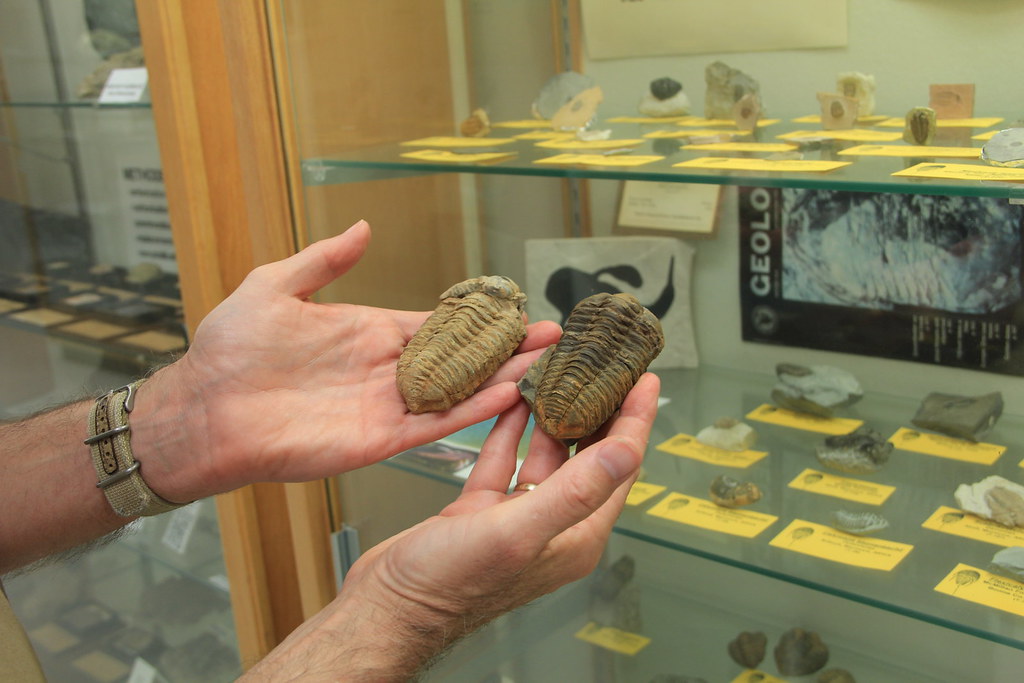The David J. Fitzgerald Museum of Earth Sciences
The David J. Fitzgerald Museum of Earth Science is an educational component of the Department of Environmental Science and Sustainability. This museum contains exhibits that display the findings of various minerals, fossils and other geological elements. Below is a sample of the many items collected over the years that have allowed students and staff to create the captivating museum we have today.
To see the collection in person, visit us in Garni Science Hall, Second Floor. There you will find maps and descriptive infographics that showcase all the samples featured within the cabinets.
Earth Explorer’s Nook
Volcano Experiment
Video created by St. Mary’s University Engineering Science major Magali Rodriguez.Rock Density Demo
Video created by Ana Diaz (B.S. ’24) from St. Mary’s University.
Specimen of the Month
July 2024: Iceland Spar

On a hot July day, we often find ourselves thinking of cooler places. This month, we are focusing on Iceland spar, a fascinating variety of calcite known for its optical wonders. Also referred to as optical calcite or rhombohedral calcite, Iceland spar was first identified in Iceland, which is how it got its name. Though it can be found worldwide under suitable geological conditions, Iceland spar is composed of calcium carbonate, just like other forms of calcite, but is typically transparent in this form.
Iceland spar has many uses, including its unique property of double refraction or birefringence. When viewed through this mineral, you see a double image due to the light splitting into multiple paths. This characteristic has historically been significant in the study of optics.
Iceland spar is also known as Viking stone. It is believed that the Vikings used it for navigation, as its polarizing ability allowed them to locate the sun even in poor weather. While Iceland spar is no longer widely used in navigation, it continues to hold scientific and industrial importance. It is utilized in optical instruments, polarizing microscopes, and various scientific experiments where its optical properties are valuable.
References:
- Birefringence in Calcite Crystals. Nikon’s MicroscopyU. [accessed May 6, 2024] https://www.microscopyu.com/tutorials/birefringence-in-calcite-crystals.
- Viking Sunstone – Iceland Spar – Facts and Sources. 2021 May 25. [accessed May 6, 2024] Nordic Culture. https://skjalden.com/viking-sunstone/.
Past Featured Specimens
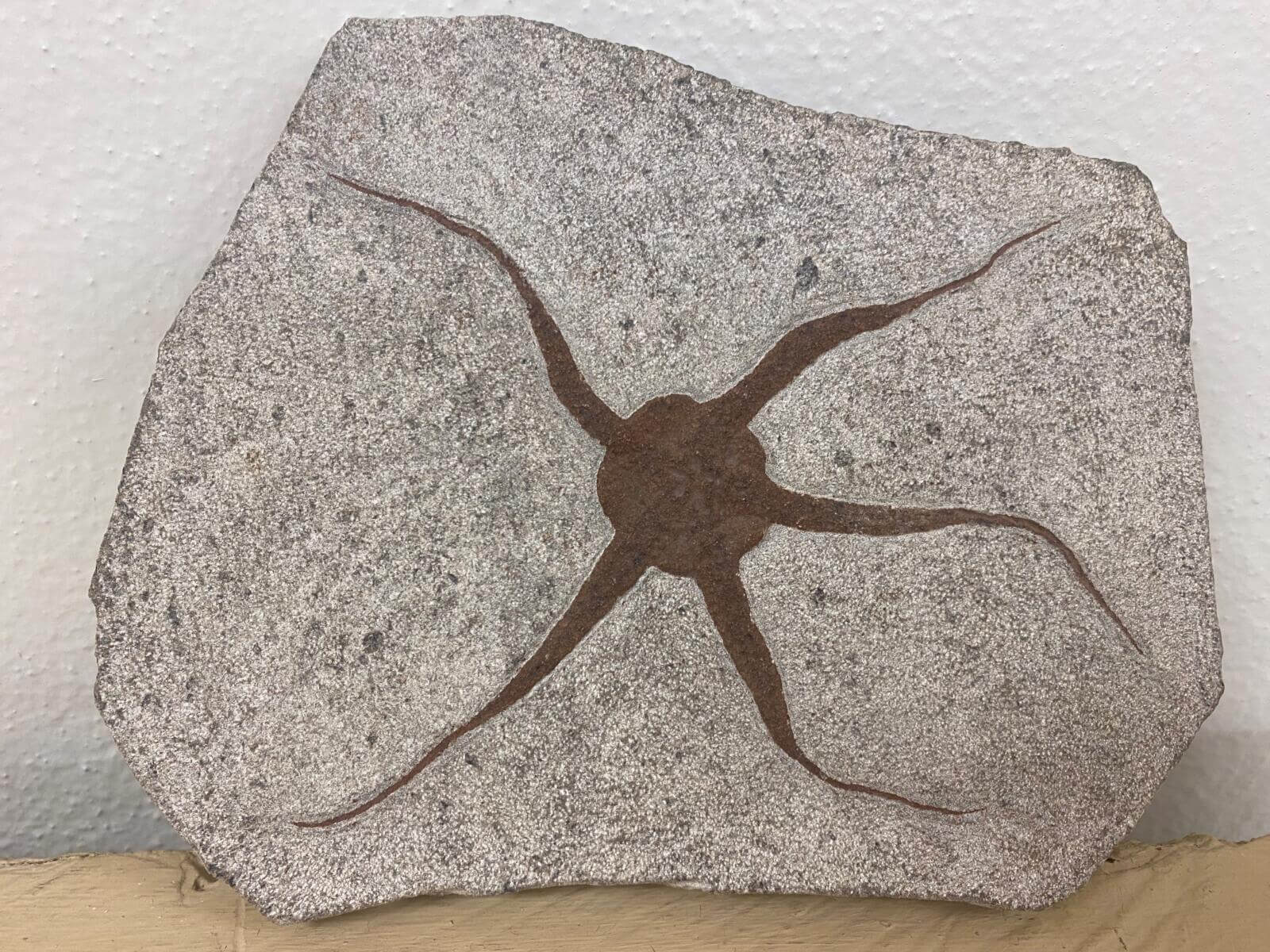
With summer starting, it is time to think about hitting the beach. In the Fitzgerald Earth Science Museum, we have many specimens that relate to marine and coastal areas. Among these is an interesting fossil of an Ophiuroid, commonly known as the Brittle Sea Star.
Ophiuroidea are well documented as having a long history on Earth, appearing first in the Ordovician period roughly 500 million years ago. Their fossils are uncommon finds as the creatures tended to fall to pieces quickly after the end of their life. The specimen shown here has a well-defined disk-shaped body with long flexible arms that allowed the animal to move by rapidly wriggling the arms in the water.
Ophiuroidea are in the class of echinoderms and are closely related to modern starfish. Many species of modern Ophiuroidea are present in the world’s oceans today. They are well adapted to a variety of environments and can live in brackish water allowing them to live in areas with a mixture of fresh and ocean water. In some habitats they are so prolific that they carpet the ocean floor. Ophiuroidea also have the ability to lose and regrow arms if they need to get away from a predator. To learn more about living brittle stars, watch Facts: The Brittle Star.
Facts: The Brittle Star. wwwyoutubecom. [accessed 2024 May 7]. https://www.youtube.com/watch?v=ST63vr_9woY&t=34s.
Ophiuroidea. Digital Atlas of Ancient Life. [accessed May 7, 2024] https://www.digitalatlasofancientlife.org/learn/echinodermata/ophiuroidea/.
The Ophiuroidea. ucmpberkeleyedu. [accessed May 6, 2024] https://ucmp.berkeley.edu/echinodermata/ophiuroidea.html.
June 2024: Ophiuroid (Brittle Sea Star)
Kyanite is a mineral composite of aluminum silicate, belonging to the silicate mineral group. Kyanite forms as a metamorphic rock under high pressure and temperatures of 350 – 600 ˚C. The distinct metamorphic conditions to produce kyanite can be found in mountain building environments and kyanite is a polymorph of andalusite and sillimanite. Additional regions where this mineral can be found include sections of the Himalayas Mountains (Asia), the Alps Mountains (Europe), the Appalachians Mountains (North America). A distinct characteristic in identifying kyanite is its crystal structure of long bladed crystals, with the colors ranging from hues of blue, white and gray. Kyanite structure and the differing hues makes pleochroism (the absorbing of different wavelengths of light due to the direction of the incoming light and polarization) occur, highlighting different colors when viewed from different angles.
Today kyanite is collected by rock collectors often showcasing the unique color of the shifting blue hues. Some jewelers use kyanite as a gemstone but due to its relatively low hardness it is less commonly used. Kyanite on the other hand is used as a refractory material, as its high temperature boiling point and resistance to thermal shock make it highly desirable for high-temperature environments like kilns and furnaces. It is also an excellent insulator and can be used as an abrasive in applications like grinding wheels and sand paper.
Herlinger, Jilian. (Sept. 6, 2022). Bruce Dice Mineralogical Museum. Mineral Spotlight: Kyanite https://calvin.edu/academics/departments-programs/geo/bruce-dice-mineralogical-museum/Mineral-Spotlights/Kyanite.pdf
Hudson Institute of Minerology. (April 17, 2024). Kyanite. https://www.mindat.org/min-2303.html
May 2024: Kyanite (Minas Gerais, Brazil)
The Manicina species of coral that is found in Florida’s coral reefs are commonly known as the star coral. This species can exhibit different colors, ranging from brown to pink, depending on factors like sunlight and water quality. As a foundational species, it provides essential habitat and shelter for numerous marine organisms. Protecting Manicina coral involves implementing sustainable fishing practices, reducing pollution, and establishing protected areas to protect the habitat from overfishing and coastal development. Multiple companies and organizations are involved in efforts to protect the coral reefs where the Manicina species and many other species reside, such as the NOAA Coral Reef Conservation Program and the Coral Reef Alliance. The Manicina species of coral was first documented in the 18th century in Florida but its distribution of similar species can be found throughout the Caribbean and the tropical Atlantic region. These include other members of the Mussidae family, such as Diploria and Favia corals, which share similar ecological roles. Studying the species provides insights into the evolutionary history and ecological dynamics of coral reefs across the region. By understanding the evolutionary history, scientists can predict how ecosystems may respond to environmental changes through climate change and ocean pollution. If you are interested in learning more about the Manicina species and other coral species you can look into the Biscayne National Park which is located in Florida where the Manicina Species originated from.
April 2024: Manicina Species Coral (Florida)

A stalagmite is a type of rock formation that rises from the floor of a cave due to the accumulation of material deposited on the floor from ceiling drippings. Stalagmites are typically composed of calcium carbonate but may consist of lava, mud, peat, pitch, sand, sinter, and amber. Stalagmites are found on cave floors; if visited, you are encouraged not to touch the cave walls or formations. The stalagmites may break very easily and even the oil from your hands can cause them to stop growing. Through the Federal Cave Resources Protection Act, some legal penalties and actions will be taken if someone breaks cave formations. These regulations are placed to protect the formations and continue allowing the public to marvel at them for generations to come. (The stalagmites shown here were donated to the Fitzgerald Museum by the landowners more than 30 years ago.)
Stalagmites may be formed for periods ranging from a few hundred years up to one million years. Stalagmites are a valuable tool for establishing the upper limits of sea level positions through time. These formations serve as natural time capsules by preserving evidence of climates and environmental conditions over centuries. The oldest known stalagmite is 2.2 million years old from the Great Basin National Park, and the largest known stalagmite in the world exceeds 70 meters (230 ft) in height and is in Sơn Đoòng Cave, Vietnam. You can visit stalagmites at national parks such as Carlsbad Caverns in New Mexico and Wind Cave in South Dakota.
March 2024: Stalagmites
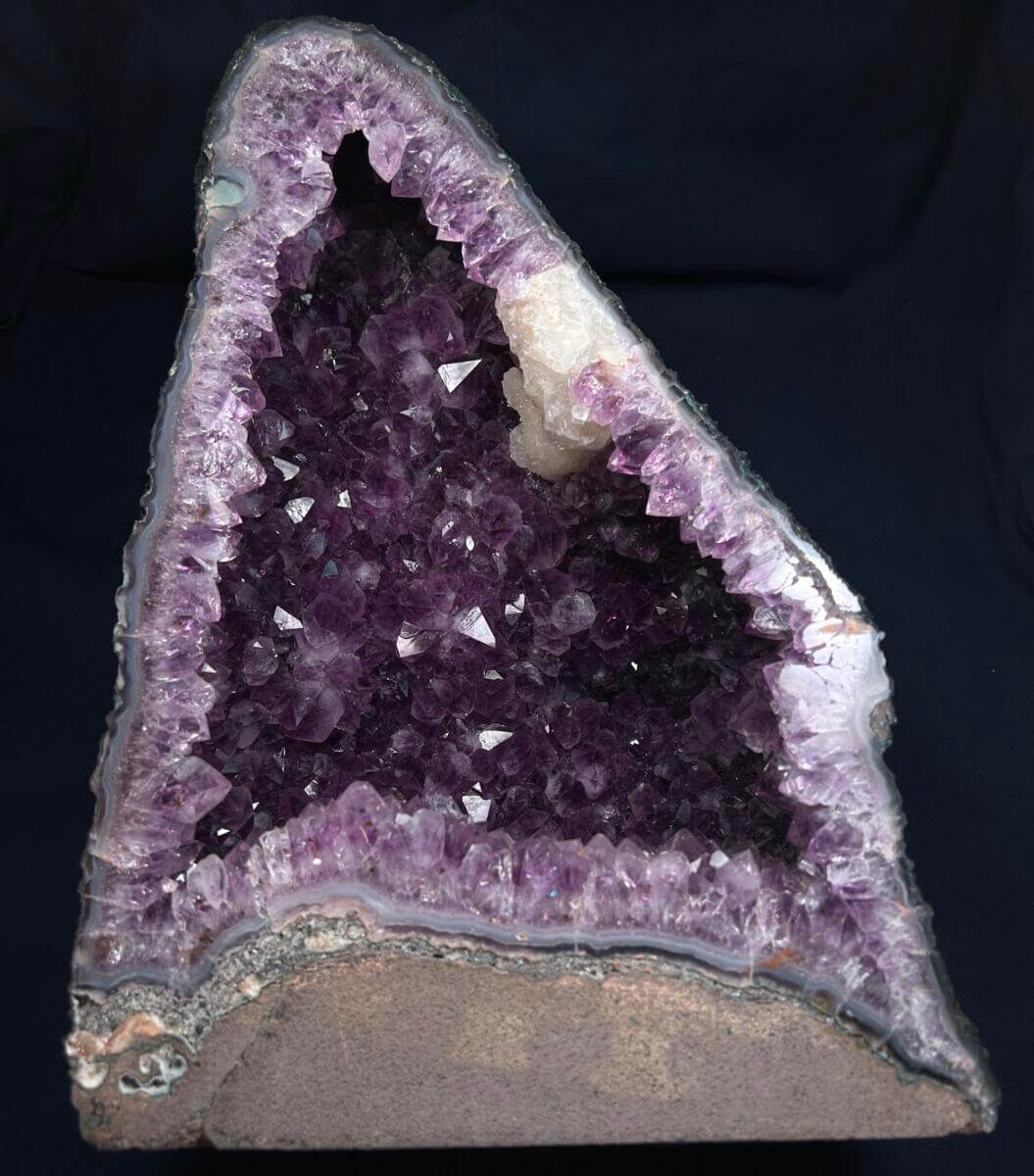

Amethyst is a popular variety of quartz renowned for its purple color that can vary in shades from light lilac to deep violet. This gemstone has a vitreous, or “glass-like” luster, which is how a gem appears when reflecting light. Aside from its gorgeous color and shine, amethyst can be identified by its hardness, which is a 7 on the Mohs scale and hexagonal or rhombohedral prism shape.
Although a more common gemstone, amethyst holds high significance in many cultures all over the world and is a popular stone used in jewelry due to its durability. Thousands of years ago Ancient Egyptians used amethyst to carve animal statues and amulets as a sign of status and that were believed to possibly bring protection to the user. Even its name comes from the Ancient Greek word, amethystos, meaning “not drunk” that comes from the mythos that if a person had an amethyst crystal in their mouth they would be protected from intoxication.
To learn more about amethyst and other quartz varieties visit our Fitzgerald Earth Science Museum or the International Gem Society website.
February 2024: Amethyst
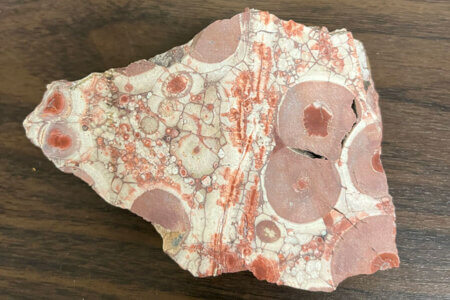
Spherulitic aggregates (spherulites) are radiating arrays of fibrous, needle-like, or acicular crystals that are common in glassy felsic volcanic rocks. Spherulitic structures result from an intergrowth of quartz and orthoclase.
These spherical bodies are thought to have formed as a consequence of rapid mineral growth after nucleation, possibly on an accumulation of volatiles, which is found in magma.
Early descriptions of spherulites are by Cross and Iddings in 1891 and by Harker in 1901. Spherulitic structures in igneous rock offer valuable insights into the complex processes that occur during volcanic eruptions and magma crystallization. These radiating aggregates, consisting of fibrous or acicular crystals, provide a visual record of the dynamic conditions within volcanic environments. The intergrowth of quartz and orthoclase in spherulites reflects the intricate interplay of minerals during cooling and solidification. The presence of spherulites in felsic volcanic rocks suggests that these unique structures may hold clues about the origin and evolution of magmas, shedding light on the history of Earth’s geology. If you would like to find more igneous rocks and their different structures, you can check out the Natural History Museum In South Kensington.
January 2024: Spherulitic Structure in Igneous Rock
Sweetwater Mine, MI
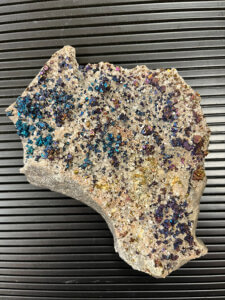
A chalcopyrite, which is the base of this specimen, is a metallic copper iron sulfide material that occurs in nearly all sulfide deposits. It was first introduced by Hackel in 1725 and is often confused with pyrite but is distinguishable through its hardness and iridescent tarnish. Chalcopyrite is a common mineral found in ore veins deposited at medium and high temperatures.
Dolomite, which can be found right on top of the chalcopyrite when looking at the specimen, is a type of limestone that is rich in magnesium, carbonate and calcium carbonate. Dolomite can be found in warm, shallow, marine environments and can form shells around other minerals. This mineral can be identified through its crystals that are colorless or white and seem to be translucent or opaque.
The final mineral found in this specimen that is placed on top of the dolomite is bornite. Bornite is known as peacock ore which is a sulfide mineral. The ore crystalizes as a bronzy dull color but rapidly tarnishes in air to iridescent colors as shown in the image. This mineral is found in igneous, metamorphic and sedimentary rocks with enriched zones of many sulfide mineral deposits. While this specimen was found in the Michigan Sweetwater Mine. you can find more minerals like this at the Smithsonian National Museum of Natural History.
December 2023: Chalcopyrite with Dolomite and Bornite
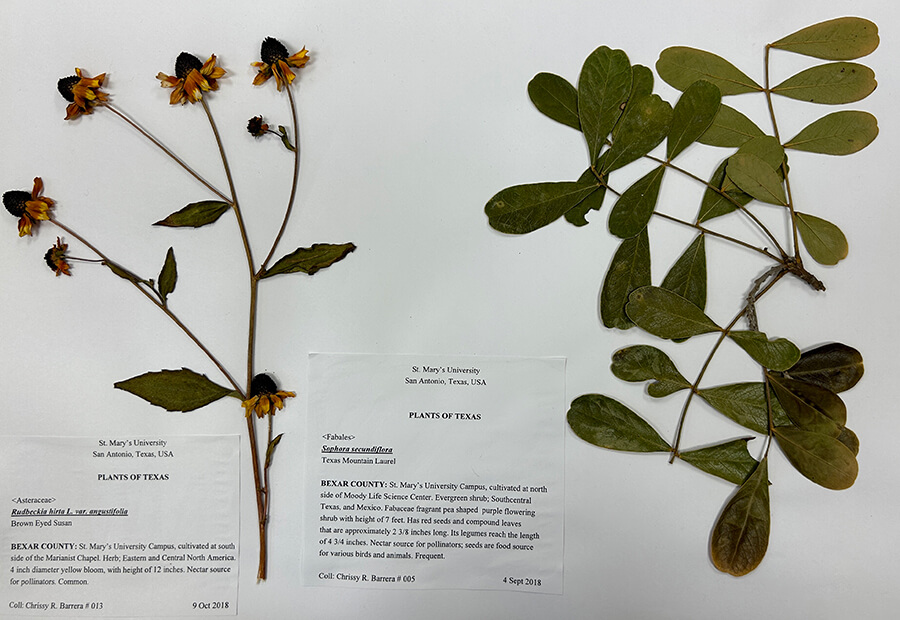
Herbarium specimens, as seen above, are methodically arranged dried plants that have been pressed and mounted on paper. Collections of these preserved plant specimens make up herbaria, which are used around the world for botanical research.
A well-preserved and well-documented herbarium specimen can give scientists insight into the plant’s geographic distribution, biodiversity of an ecosystem and the climate at the time it was collected.
Since these preserved specimens can last for hundreds of years, they can help us to understand the history of a geographic location, especially with plants that are endangered or extinct. With our current and ever-advancing technology, researchers can even sequence DNA from herbarium specimens to analyze their genetic diversity and evolutionary history (phylogenetics).
The specimens in our museum were collected by previous St. Mary’s students as a part of our Environmental Science courses, but there are many herbarium collections in Texas. To learn more about herbaria visit Fort Worth Botanical Garden, San Antonio Botanical Garden and the Smithsonian Museum of Natural History.
November 2023: Herbarium
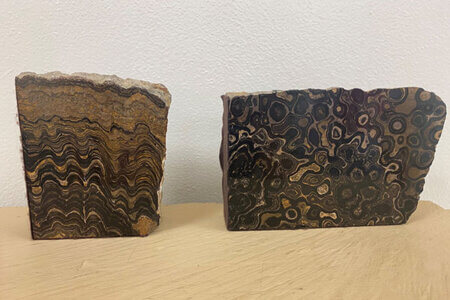
Stromatolites are fossilized algae that first show up in the fossil record during the Precambrian era. During the Precambrian era, the blue-green algae known as cyanobacteria started producing oxygen through photosynthesis, introducing oxygen into the atmosphere and establishing the Ozone layer. This change in our atmosphere led to more stability of Earth’s climate, blocking out higher energy ultraviolet radiation, and setting up the right conditions for the Cambrian explosion of life. As single-celled bacteria, they quickly spread and multiplied, often creating microbial mats that promoted the layering of foreign sediments and resulted in the lithification of the sediments to the algae. This pattern led to the layered and patterned fossils identified in the rock record today.
Cyanobacteria once covered the entire planet, but in their photosynthetic activities, they greatly reduced the amount of carbon dioxide in the atmosphere. This led to a cooling of the planet and a reduction of the food supply. These conditions created what is known as the “oxygen catastrophe”, where there was a great abundance of oxygen in the atmosphere produced through photosynthesis, but not enough carbon dioxide to sustain the massive cyanobacteria colonies. Today, while there are many fossil examples of this life form, live stromatolites only exist in four locations in the world: Shark Bay Australia, Cuatrocienegas Basin, Mexico, Lake Bacalar, Mexico, and along the coast of South Africa.
October 2023: Stromatolites

Crinoids, are marine animals that attach to the sea bottom. The variety that have a stalk are commonly referred to as “sea lilies”. These creatures first show up in the fossil record during the mid-Cambrian part of the Paleozoic era and were much larger and prolific at that time then specimens today. Different species of crinoids have been present on the Earth for about 500 million years. You can read more about the history of crinoid evolution here.
Because crinoids grow in marine environments, finding fossils of these animals tells scientists that the rocky areas where they are found were once covered with water. This helps to construct the geologic history of our planet.
The stem pieces, as shown in the front of the image, are the most commonly found portion of the crinoid in the fossil record. The tentacles or “flowers” are typically a rarer find. The other specimen in the image shows multiple flowers and the structure tells us about the type of crinoid. This species is a Scyphocrinites elegans from the Silurian time period. Many of these specimens can be found in modern-day Morocco.
September 2023: Crinoids
August 2023: Dinosaur Footprint Reproductions
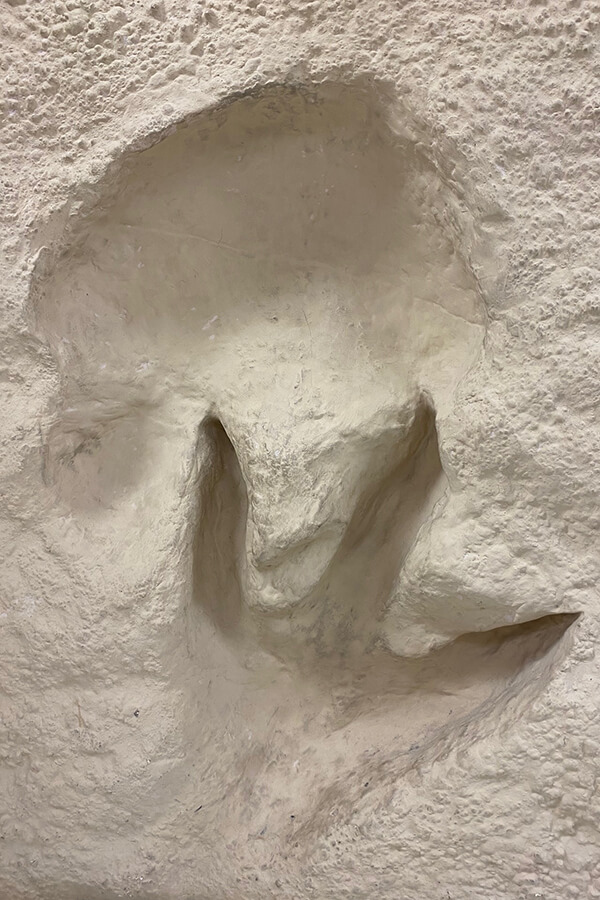
The Fitzgerald Earth Science Museum is fortunate to have on display reproductions made of tracks from two different dinosaur species. The display was created by pouring plaster into two footprints found in the Paluxy River, west of Glen Rose, Texas, to create casts. Two expeditions by St. Mary’s faculty from the Biology Department were made in 1940 to collect the casts. The hardened casts were then used to make new impressions in the plaster base that is on display.
The two tracks seen on the reproduction are from animals that existed around 120 million years ago. The shapes of the different tracks tell a story about what life lived in the area. The rounded impression is from a Sauropod, one of the species of vegetarian gentle giants that roamed the landscape like the well-known Brontosaurus. The three-toed track is made by a bipedal, carnivorous dinosaur similar to a Tyrannosaurus.
Dinosaur tracks such as these can be viewed in a number of locations in Texas, such as Government Canyon State Natural Area, The Heritage Museum of the Texas Hill Country and Dinosaur Valley State Park.
You can also learn more about dinosaurs at the Texas Memorial Museum, the Witte Museum, the Houston Museum of Natural Science and the Perot Museum of Nature and Science.
August 2023: Dinosaur Footprint Reproductions
July 2023: Fungia
Origin: Unknown
Species: F. fungites
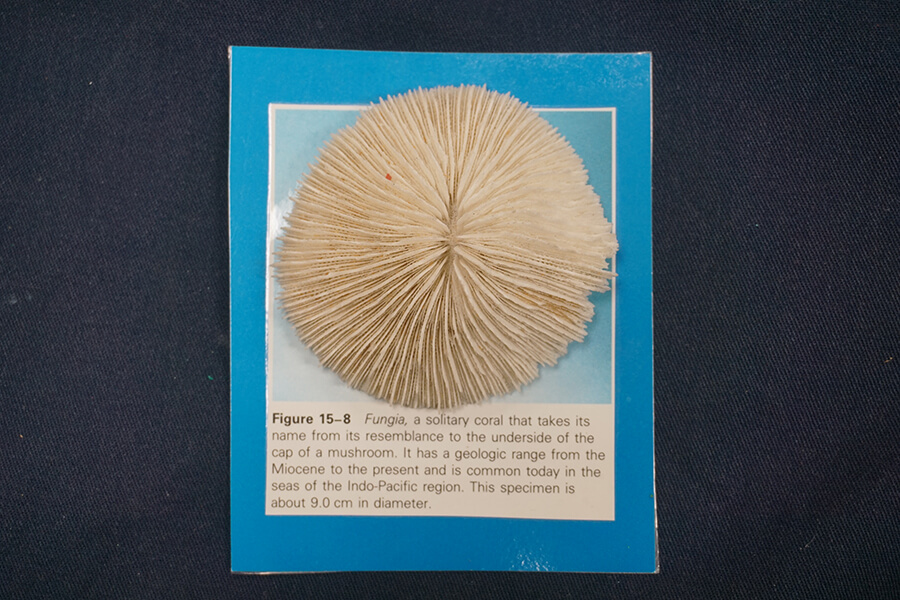
These solitary species live freely amongst the waters and come from the Miocene period. They can be found today in places of the Indo-West Pacific, Western Central Pacific, and Western Indian Ocean, as well as the Northwest Pacific. These round plates move often and can move up to 12” per day (30cm). Their movement is carried by the water and currents. The water is also a safety harness for these small creatures as when they are buried under sediments or sand, they fill up their tissues with water to then release it and to be taken with the current as transportation.
Fungia corals are shaped as round disks that have short tentacles that can retract during the day and or the night. They often retract their tentacles themselves when they feel harmed or disturbed. Their mouths are sticking out on top of one another from the center and can have various sizes of mouths. Because there can be exposure to their mouths, a parasite called bivalve gastropod Faungiacava eilatensis lives in their mouths. The fungia often get their sources from small organisms and nutrients from dissolved organic matter.
July 2023: Fungia
June 2023: Great White Shark Tooth
Origin: South Carolina
Species: Carcharodon megalodon
Great white sharks are one of the world’s largest predators alive and evolved from ancient sharks called the Megalodon (Carcharodon or otodus megalodon). This specific specimen originates from the Miocene Epoch, 23.03 to 5.3 million years ago, which was a time of a warmer climate for many years and other animals during this evolution. There was research found on shark population numbers from the Miocene epoch, that questioned a possible wipe-out of nearly 90% of sharks declined by data showing a difference in sediments of shark fossils.
They live in the oceans and are found all around the globe including places in the coastal areas and offshore with water temperatures of 12 to 24 degrees Celsius (54- and 75 degrees Fahrenheit.) High concentrations of the species can be found in the United States, Japan, Oceania, Chile, South Africa and the Mediterranean.
June 2023: Great White Shark Tooth
May 2023: Malachite
Oppenheimer Collection
Origin: Unknown
Mineral Type: Copper carbonate hydroxide
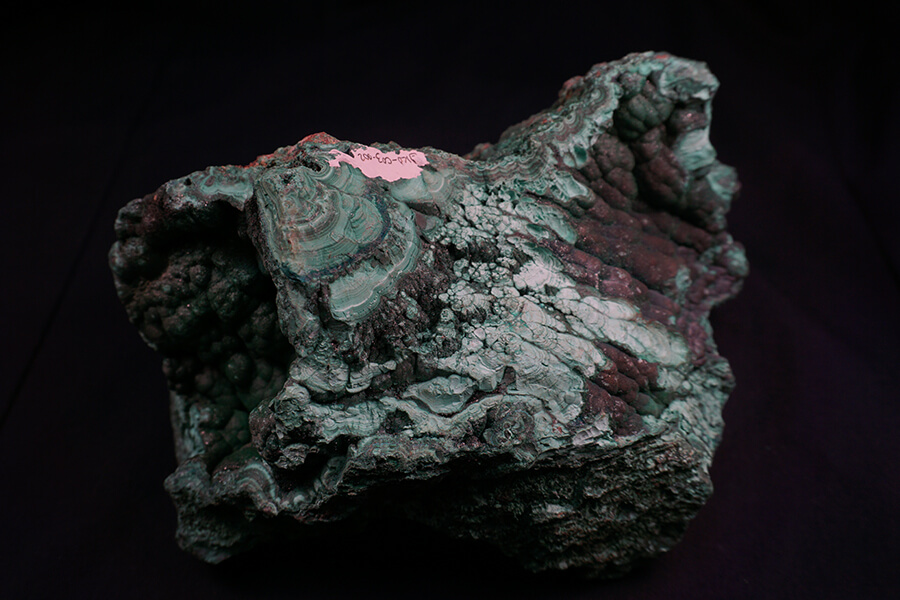
Malachite comes from the oxidizing zone in the shallows of the Earth around copper deposits. They often fall from solutions in caverns, cavities, and intergranular spaces of porous rocks. Their composition is mostly of carbonate and copper minerals, so, there are rarely any crystals to be found and are usually acicular and mostly clear. Their gravity range is high from 3.6 to 4.0, meaning that because of this property, the green mineral is easy to identify.
Malachite was first found in areas of Egypt and Israel and over 4000 years ago were they mined for the making of copper. Though they were mainly produced for copper, these days they are not used as often, and much of the market on malachite comes from deposits in the Democratic Republic of the Congo, as well as Australia, France, and Arizona.
May 2023: Malachite
April 2023: Aragonite
Oppenheimer Collection (Kathi and John Oppenheimer, Law School Class of 68’)
Mineral Type: Carbonate mineral
Location: Australia

The Aragonite photographed above is also a part of the newest addition to the David Fitzgerald J. Museum, the Oppenheimer Collection. Aragonite is a high-pressure polymorph of calcium carbonate; therefore, it occurs in high-pressure metamorphic rock such as those formed in subduction zones.Aragonite are tabular, prismatic or needle-like often with steep pyramidal-shaped ends. Samples can be white, colorless, gray, yellowish, green, blue, reddish, purple or brown. Aragonite provides essential materials for marine life and keeps the pH of the water close to its natural level to prevent the dissolution of biogenic calcium carbonate.
April 2023: Aragonite
March 2023: Brush Coral
Acropora Hyacinthus
Location: Unknown

Brush coral is the most abundant coral of exposed outer reef slopes and is mostly found in the upper reef slopes and outer reef flats. Brush corals are grouped in colonies which can be observed as wide flat plates and tables or tiered aggregations of small plates. Branchlets are thin and finely structured except when exposed to wave action, which then become closely fused. Branchlets are fine and upward-projecting. It is thought to have a range that includes the Indian Ocean, the Indo-Pacific waters, southeast Asia, Japan, the East China Sea and the western Pacific Ocean. Figures of its population are unknown, but it is likely to be threatened by the global reduction of coral reefs, and the increase in temperature causing coral bleaching.The image shown above shows the physical consequences of coral bleaching in which the colorful appearance of coral is taken away, leaving a white cast as seen in this sample.
March 2023: Brush Coral
February 2023: Fluorite
Oppenheimer Collection (Kathi and John Oppenheimer, Law School Class of 68’)
Mineral Type: Fluorite
Location: Blanchard Mine, New Mexico

The Fluorite pictured is a part of the Oppenheimer Collection, found in Blanchard Mine, New Mexico. Fluorites are mainly found in hydrothermal veins.
Fluorites are pore-filling materials found in carbonate rocks like limestone and dolostones. When it comes to the hydrothermal veins, they are through low and high-temperature hydrothermal fluids and can be rich in fluorite. They can be found all over the world in different places. As well as other minerals in granites, greisen, pegmatites and other veins with higher temperatures.
The mineral itself is made up of calcium fluoride. It can come in different colors and sizes. Some common colors of Fluorite are purple, blue, brown, gold, yellow and lilac. Fluorite can be used for many different things such as flux or smelting for varieties of chemical, metallurgical and ceramic processes.
As far as manufacturing goes, Fluorite was used to manufacture chlorofluorocarbons (CFCs) for refrigerants and aerosol sprays. Recent studies have shown that it has contributed to concerns about CFCs’ impact of the Earth’s ozone layer.

